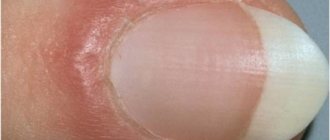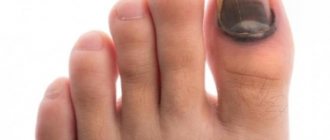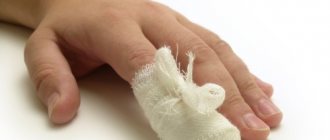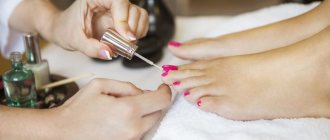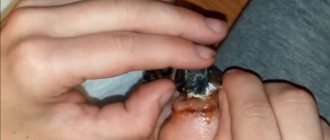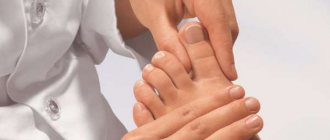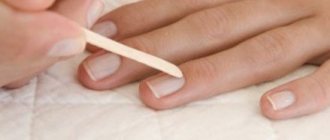Causes
If a finger was bruised and turned blue, this indicates that the small blood vessels at the site of injury are damaged. Blood begins to flow out of them, which is dissected into the surrounding soft tissue under the skin. Blood contains a large amount of hemoglobin, which gives it a bright purple hue. A fresh bruise, thanks to hemoglobin, has a purple color.
White blood cells, called leukocytes, begin to flow to the site of injury. They begin to surround the rupture site, destroying the blood cells that have leaked out. The breakdown of hemoglobin in red cells is responsible for the consistent change in color of a bruise.
The products of hemoglobin destruction are bilirubin (yellow-red bile pigment) and biliverdin (green bile pigment). When hemoglobin is destroyed, the cyanosis changes color from red through lilac cherry to yellow-green. Afterwards, the decay products at the site of injury leave, and the color disappears. Bilirubin is absorbed by the liver, where it is converted into bile and is directly involved in the digestion of food.
Degree of injury
In total, experts consider 4 degrees of finger bruising. This:
- First . There is minor damage to the epidermis, there may be abrasions and scratches.
- Second . In the second degree, the finger turns blue and swells when bruised, muscle tissue and all layers of the dermis are damaged. There is pain at the site of the impact for a long period of time.
- Third . The finger is swollen and blue due to the bruise, and there is damage to the muscle tissue and tendons. It is at this degree that dislocations are observed, which are most often treated on an outpatient basis.
- Fourth . This is the most severe degree. At this stage, muscles and tendons are torn, severe pain and a large hematoma occur. In such a situation, patients note that when a finger is bruised, it becomes swollen and blue, and sometimes even has a black tint. A fracture is very common. This type of injury requires immediate medical attention. It is possible to prescribe antibacterial drugs. If conservative treatment is not possible, surgery may be performed.
If the injury occurs in a child, then you should consult a doctor even in the first degree.
Classification of bruises
There are 4 degrees of injury severity:
- The damage is minor, slight redness and scratches may occur. No visit to the doctor is required. The pain goes away within a few minutes, and other symptoms disappear within two days.
- After a blow, severe pain appears in the bruised finger, which quickly passes. There is slight damage to the capillaries, which leads to the appearance of a slight hematoma, and swelling may occur.
- It is the result of a strong blow to a blunt object. Muscle tissue and blood vessels are damaged. You can see that the finger has turned blue and there is an extensive hematoma. Some time (about an hour) after the injury, the tissues swell, which limits the mobility of the joints. A severe bruise may be accompanied by a dislocation.
- Characterized by complete impairment of the motor function of the finger. The affected area becomes very swollen. Often there are cracks in the bones, swelling of the entire foot, damage to blood vessels, tendons, nail plates and joints.
Main symptoms
If the fingers are injured due to impacts, then most often the affected finger begins to swell and turn blue. Swelling and pain in the finger after injury are quite pronounced. The patient is unable to bend or straighten his finger. Hematomas vary in size.
Quite often, a severe bruise of a finger does not make it possible to carry out full activities. In this case, you have to go to the clinic. It is advisable to consult a doctor when the hematoma does not go away for a long period of time, the finger becomes hot to the touch, and the body temperature rises.
It is very important to see a doctor, because if the finger turns blue when bruised, this may indicate a fracture. But in addition, pathological mobility is noted, which is also typical for dislocation. The pain will be several times stronger.
If the blow was strong, then the symptoms of the bruise are as follows:
- acute and unbearable pain at the site of impact;
- the finger does not bend when the hand is bruised;
- the appearance of pathological mobility of the bruised finger;
- the appearance of swelling or displacement;
- the appearance of a crack when a finger is bruised;
- open bleeding from the wound.
Based on the symptoms, it is necessary to make a diagnosis. Only after this can you begin quality treatment. When considering how long a stubbed toe hurts, several factors come into play. These are the severity of the injury, how quickly first aid was provided, and the quality of the treatment provided. In untreated cases, a bruised finger can be cured in 3-4 days. But if there is no competent therapy, then treatment may take a couple of weeks.
Characteristic symptoms
Stubbed big toe and little toe are the most common foot injuries. The main symptoms of a bruised toe: pain that gradually subsides, increased temperature in the area of impact due to a rush of blood, redness and swelling.
If a toe is severely bruised, a hematoma may occur under the nail. It is characterized by the appearance of blood under the nail plate followed by darkening. The victim feels swelling and pulsation at the site of injury. With particularly strong impacts, the nail plate may crack or fall off completely or partially.
How to distinguish a bruised toe from a dislocation and a fracture at home? It's actually not difficult to do this. Here are a few differences between a bruise and a fracture:
First, evaluate the force of the blow received. The pain from the bruise will be very strong at the very beginning, but will gradually subside. The pain from a mild bruise goes away in a few minutes, but from a severe one it lasts up to 20 minutes. The pain of a fracture only increases.
The functionality of the finger in case of a bruise is preserved, which does not interfere with walking, but in case of a fracture there may be no mobility. With unbearable pain and lack of finger mobility, walking will bring a lot of discomfort.
Tissue swelling and hematoma (bruising) can occur in both cases. However, in a situation with a fracture, swelling occurs almost immediately and does not go away, but only increases. Hematoma and swelling from the bruise appear after some time.
Try to feel the injured finger. If the bones are not interrupted and are in their natural position, then you have a bruise.
A severely bruised toe can lead to a dislocation. With such damage, the toe is in an unnatural position and it is very painful to touch it. When a dislocation occurs, the bones in the joint capsule are displaced. The damaged toe becomes immobile, while the integrity of the bones is maintained.
How to determine if a finger is broken or bruised
When a finger is injured, it is very important to immediately determine whether it is broken or simply bruised, since the symptoms are similar. To find out, you need to pay attention to pain and sensitivity. The first sign of a fracture is severe pain. The intensity of pain depends on the severity of the injury.
A patient who has suffered a bruised finger or a crack should be alerted to the following signs:
- pathological mobility of the limb, fingers at the site of injury;
- prolonged pain that is poorly relieved by painkillers;
- progressive swelling and cyanosis of the epidermis;
- crunching sound when palpating the sore area;
- unnatural position of the fingers.
If such symptoms occur, you should consult a doctor as soon as possible. The doctor will conduct an X-ray examination, which can rule out or confirm the presence of a fracture. With such symptoms, you should never self-medicate, so as not to aggravate the situation.
Treatment of bruise
The traumatologist can draw a conclusion about the severity of the injury based on x-rays. If there is no severe damage, then there is no need to apply plaster. In most cases, a bruised finger can be treated at home. Necessary:
- take painkillers if necessary;
- perform physiological procedures;
- apply creams and ointments with a restorative effect.
If the damage is serious, resulting in the nail plate being torn off, the doctor will also prescribe antibacterial drugs. Torn ligaments mean surgical intervention, because they need to be sewn together.
First aid to the victim
In order to prevent complications and unpleasant consequences, it is important to correctly immediately provide first aid in case of a finger injury from an impact.
First aid for a bruise is:
- Apply a cold compress to the bruised area immediately after the injury. This can be a towel soaked in cold water, or a piece of ice wrapped in a cloth. In the latter case, it is necessary to wrap the ice, as this will help avoid frostbite of the tissues. It is also possible to simply hold your hand under running cold water.
- Antiseptic treatment. If there are open wounds, the finger will need to be disinfected and a suspension applied. Without such actions, infection may occur, which will lead to very unpleasant consequences.
- Use of analgesics. If the pain is severe, give the victim a painkiller. This could be Analgin, Ketorol.
- Applying a suspensor. Even if there is no damage, you will need to apply a tight bandage. This will help to significantly cope with unpleasant sensations.
If there are dislocations, it is strictly forbidden to try to straighten it yourself.
First aid
Anyone can evaluate an injury using the signs of the four listed conditions. And in accordance with your own feelings, begin to provide first aid to yourself.
As a rule, bruises of the first two degrees of severity can be cured at home if you follow some rules.
- Do not use the “it hurts and it goes away” rule. Gently feel the stubbed finger phalanx by phalanx, paying attention to the knuckles and nail. If the signs of a bruise correspond to the first or second degree of injury, you do not need to contact a doctor. But you need to start helping yourself immediately, remembering that even a minor bruise in the future can come back to haunt you with a chronic joint disease.
- Help for a first or second degree injury involves immediately applying a cold or even ice compress to the injury site. This procedure will prevent swelling from occurring. Or it will significantly slow down its formation and reduce its size.
- But there are nuances. You cannot apply ice directly to the bruise, otherwise there is a risk of elementary frostbite in the bruised area. Therefore, it is better to wrap the ice in polyethylene, and the resulting bag also in woven material. Change every 10 minutes if possible.
- It is advisable to place a soft pad between the sore and adjacent fingers, because any direct contact with a foreign object will be painful.
- Scratches and abrasions, if any, should be treated with hydrogen peroxide and then blotted dry. You should not lubricate with iodine: iodine tincture has a warming effect that will negate your attempts to relieve swelling. It is better to use brilliant green or mercurochrome.
- Secure the joint with a tight bandage - as a preventive measure, this measure will not be superfluous.
- Use special ointments for bruises that have a cooling effect. Heparin-based ointments are also effective: Lavenum, Trombless gel. With arnica – Vitateca and Arnigel. Non-steroidal - Diclofenac ointment, Indomethacin, Ibuprofen and Antistax gel.
- All of the above drugs are applied only to the skin without wounds or abrasions. There is only one exception to this rule - balsamic liniment according to Vishnevsky. It can be applied directly to an open wound, it only promotes its healing.
Difficulties may arise in the event of injury of the third and, especially, fourth degree of severity. With the third, even if there is no crack in the bone or fracture, damage to nerve endings, muscles and, most unpleasantly, tendons is possible. It is no longer possible to do without medical assistance, expressed in the application of a plaster cast with partial immobilization of the finger joints.
Even more serious consequences can occur with a fracture, when hospitalization is not only desirable, but also vital: because of such a “trifle” as a toe, you can get lifelong disability. Why?
Grade 4 in 100% of cases is characterized by an extensive hematoma. A hematoma is blood that has coagulated from broken capillaries as a result of injury. Sometimes clots of dried blood are so large that they tear muscle tissue, forming cavities in which the process of putrefaction begins. The result is gangrene, which can spread to the entire foot and beyond.
So, if you have a 4th degree lesion, you should contact a medical facility in any case.
Treatment in hospital
When considering what to do for blue fingers due to a bruise, it is worth considering the option of treatment in the hospital. In the hospital, specialists with injuries help fight hematomas. To do this, doctors use the following methods:
- Resorption therapy . The occurrence of bruising is a consequence of the accumulation of hemoglobin under the epidermis. The moment the blood is poured out, it coagulates and turns into hemosiderin. Because of this, the skin is painted in a characteristic color. This substance can be eliminated by increasing metabolism. To do this, use ointments that help increase blood circulation.
- Normalization of blood flow. While the hematoma is fresh, it is necessary to narrow the vessels in the affected area in order to reduce the amount of blood spilled into the tissue. To get rid of cyanosis, Badyaga is indicated. The drug has a local irritant effect.
- Physiotherapeutic procedures . If the finger turns blue after an injury, the specialist recommends hardware assistance in the form of cryotherapy, laser heating, darsonval, and magnetic therapy. Such techniques allow you to launch the body’s protective functions, normalize microcirculation, and quickly eliminate cyanosis and swelling.
But in most cases, treatment is carried out at home.
How to treat a bruised nail
The first and most important rule when treating a bruised fingernail is to provide complete rest to the injured area.
Put everything aside for a few days and try not to unnecessarily disturb your hand and the directly injured finger. This needs to be done for about three days. After the third day, the hematoma begins to gradually resolve. As a preventive measure, it is necessary to use heparin ointment. It is this remedy that will prevent the blood from clotting, and the hematoma on the finger will disappear several times faster. Arnica ointment is also effective; it eliminates the inflammatory process in the area of the damaged nail. Apply both ointments to the bruised nail two to three times a day.
For a week after injury, you can do it before bed and leave it on for 30 minutes with a special compress with dimexide. To prepare it, you need to dilute dimexide in novocaine (ratio 1:3). Moisten gauze well in this mixture and apply to the injured fingernail. Next, wrap your finger with gauze in cling film, put a little cotton wool on top and secure the entire compress securely with a sterile bandage.
A badyaga bruise heals quite well. It is sold in powder form. It needs to be mixed with a small amount of water to form a mixture that looks like dough. Next, apply the badyagu to your finger and leave for a while. In addition, a little powder can be added to one of the ointments that you use to treat a bruised nail.
The ideal option would be to treat the nail immediately after injury with Riciniol.
This is the name given to the emulsion, which is prepared from castor oil.
The emulsion differs directly from the oil in that it contains ricinoleic acid in a free state. This acid has a very positive effect on wounds: it promotes faster healing, relieves pain and prevents inflammation from occurring in the damaged area of the body. If immediately after a bruise you treat your finger with an emulsion of castor oil, then in almost all cases swelling does not appear, and the process of soft tissue restoration is accelerated several times.
TOP 4 remedies for fighting bruises
If your fingers become blue and swollen due to a bruise, then it is advisable to use ointments. Let's look at the TOP 4 best tools:
- Troxevasin . The active component of the drug is troxerutin, which allows you to reduce and completely eliminate the fragility of blood vessels, strengthen their walls, reduce swelling, and stop the acute inflammatory process caused by damage to the vascular wall. In relation to hematomas, the active component prevents re-damage after vascular injury. The gel is applied twice a day. The drug may provoke allergic reactions.
- Badyaga . Badyagi powder is a 100% natural remedy that does not have a negative effect on the body. Very rarely Badyaga provokes allergies. The impact is based on a mild irritant effect. When rubbed into the epidermis, the substance stimulates blood microcirculation in the diseased area, which helps normalize metabolic processes and prompt recovery after injury. Bruises resolve very quickly, as the clots are actively absorbed and “dissolved.”
- Bruise-Off . The active ingredient is leech extract, which is essentially hirudin. The substance prevents blood clotting, due to which cyanosis resolves much faster. Pentoxifylline normalizes blood circulation and serves as an accelerator of regeneration processes. The gel quickly combats swelling, has a mild analgesic effect and combats such consequences as cyanosis. It is quickly absorbed, making it convenient to use.
- Heparin ointment . When considering what to do if your fingers turn blue due to bruises, be sure to choose a heparin-based ointment. One of these is Heparin ointment. Heparin prevents blood clotting and prevents the formation of blood clots. Thanks to this effect, rapid resorption of blood clots that remain under the dermis after hemorrhage is noted. The only negative is that it has a sufficient number of disadvantages.
These products help to cope with bruises on the finger as quickly as possible.
Treatment for a bruised toe
There is no treatment for a bruised toe without hematomas and swelling. If the skin is damaged, it needs to be treated. As an antiseptic and hemostatic agent you can use: hydrogen peroxide (not suitable for serious injuries), Chlorhexidine, Zelenka (do not use Iodine, because it has a warming effect), Miramistin.
If there was a dislocation during the injury, then the resetted finger must be fixed. In order to do this, the injured finger is bandaged together with the healthy neighboring one. In cases of severe injury to the thumb, a cast is often applied.
The bruised area needs rest. Place your foot on the pillow so that it is elevated. You cannot wear tight shoes, you need to limit movement on your feet.
After examining the bruise and making a diagnosis, you can take painkillers and anti-inflammatory drugs, and use ointments recommended by your doctor. They will help relieve pain and swelling and heal the damage faster.
Ointments that are prescribed for bruises for pain and swelling:
- Bodyaga;
- Indovazin;
- Heparin ointment;
- Troxevasin;
- Voltaren;
- Special lubricant;
- Rescuer;
- pain-relieving ointments based on ibuprofen, etc.
After applying the ointment, you need to apply a bandage that will prevent germs from entering the wound. Herbal infusions and lotions help to quickly cure a bruised toe. Fresh crushed plantain leaves are good for this.
If you bruise your toe, it is prohibited:
- rub and massage the damaged area (this will lead to even more swelling);
- heat and steam;
- try to manually bend fixed joints;
- adjust dislocations (only a doctor can do this correctly);
- take medications without a doctor’s prescription, including for pain;
- self-medicate if swelling does not subside for more than two days (this indicates serious damage to bones, joints or ligaments).
To prevent bruising your toes, you should wear closed shoes. It is better to wear soft slippers at home, and at work and in other places - shoes that will protect your feet from injury. You should not wear sandals to events with large crowds of people, as there is a risk of damaging your feet. You need to be careful and attentive when moving quickly around the apartment, especially in the dark.
No comments yet. Be first! 56,
Bruises occupy a leading place among all injuries, since by nature a person is endowed with activity. Blows to the fingers or toes are no exception, especially since their structure is quite fragile and when injured, it is often observed that the nail turns black. It is not difficult to get a bruised finger: physical work, falling a heavy object on a limb, exposure to the force of an impact, and many other circumstances can lead to the fact that the nail turns black.
When a finger or toe is struck, damage to the nail plate is often observed. The blow threatens to cause such a condition that after the bruise the nail turns black, and its shape changes and even peels off. In addition to the fact that the aesthetic appearance of the finger is disrupted, because it has turned black, and symptoms of severe pain appear, there is a threat of complete loss of the nail. In this case, it takes more than one week, and even a month, to return the nail to its original appearance.
The best drugs
The pharmaceutical market can be pleased with the range of drugs that help if a stubbed finger turns blue and swells. Let's look at the best medications that will help cope with the problem. This:
- Biocon-GirudoVen gel . This drug normalizes the condition of capillaries and is characterized by an anti-edematous, antiphlogistic effect. The gel helps normalize vascular patency and improves skin tone. The medication is intended for children over 12 years of age and adults. Apply up to 4 times a day. The duration of therapy is 20 days.
- Dolobene . This is a combination drug for external use. The effect of the medication is determined by the active ingredients it contains. The medicine is characterized by antiphlogistic, decongestant, local analgesic effects. Regular application promotes rapid resorption of hematoma and wound healing. Apply a loose layer to the affected area up to 4 times a day. The duration of treatment depends on the severity of symptoms.
- Lyoton-1000. Regular use of the drug suppresses the formation of blood clots. Helps eliminate the acute inflammatory process, swelling, and bruises. Apply a loose layer to the affected area.
- Ambulance . If you bruise your thumb, you should give preference to cream-balm. Does not contain antibiotics or hormones. Has high penetrating ability. It has very effective bactericidal and regenerative properties. Promotes rapid resorption of hematomas and elimination of bruises. Apply the medicine 2-3 times a day to the affected area. Pre-treat the dermis with an antiseptic. It is recommended to use until complete healing.
- Vishnevsky ointment . This product copes well with purulent-necrotic contents and promotes the rapid resorption of bruises. Before use, be sure to treat the epidermis with an antiseptic. A suspension is placed on top of the ointment.
Listed are the best remedies that are used for a bruise, if the finger is swollen and blue. But before using any gel or ointment, consult a doctor who will draw up a competent treatment regimen.
Traditional methods of therapy
After visiting your doctor, you should begin treatment. It is better to clarify with a traumatologist which methods of traditional medicine should be used to carry out therapy. You can quickly cure a bruised finger with Vishnevsky ointment. This remedy perfectly relieves swelling, and if you apply the ointment to the damaged area and cover with a bandage, you can see the first result after a few hours.
The following remedies are also very effective in treatment:
- Cabbage. Apply the sheet to the injury and secure with a bandage. It is recommended to change the bandage every half hour; it perfectly relieves inflammation and swelling.
- Bodyaga. Pharmacies sell ready-made ointment of the required consistency. To make your task easier, you can simply apply the product to the injury site and cover with a bandage, changing it about twice a day.
- Potato. It should be boiled in its uniform, kneaded and this paste applied to the injured area. This compress can be changed an unlimited number of times, it perfectly relieves pain and reduces bruises.
- Bulb onions. The best remedy for infections. It must be crushed using a blender, moisten a bandage in the resulting pulp and apply it to the bruised finger. Change the bandage twice a day: morning and evening.
- Honey, vinegar and oil. Mix all the ingredients, moisten the gauze and wrap your finger. A good remedy for relieving swelling and eliminating hemorrhage.
Information about treating a bruise will help not only you in a similar situation, but also your loved ones. The ability to provide first aid is priceless, because in this way you can even save a person’s life.
The use of folk remedies
When considering what to do if you hurt your finger and it turns blue, you should pay attention to folk remedies. Before using any prescription, you should consult your doctor.
The most effective means:
- Bodyaga . You can purchase the powder at a pharmacy and it is quite inexpensive. The product promotes the resorption of bruises and hematomas on the finger from an impact. Mix bodyaga powder with water to make a paste. Apply the resulting mixture to the sore finger. Three similar lotions are great for fresh bruises.
- Iodine . On the second day, as if your finger was swollen and turned blue due to a bruise, make an iodine grid with 5% tincture of iodine. This remedy is characterized by antiphlogistic, healing effects, and helps accelerate the resorption of cyanosis.
- Healing compress . Take half a glass of vodka, add half a small spoon of salt and stir well. Moisten a swab in the resulting product and apply to the affected area.
- Calendula . When considering what to do if your finger turns blue from a bruise, you should use calendula tincture. It can be purchased at a pharmacy or prepared independently. To prepare, take 20 g of grass flowers and add 100 ml of 70 degree alcohol. Infuse this remedy for two weeks, so it is better to prepare the elixir in advance. This drug can be stored for a long period. The resulting tincture is used for lotions and applications for bruises.
- Aloe . This plant helps if the bruise is not extensive. Take a leaf, cut it lengthwise and apply it to the bruise. For greater effect, secure the sheet with adhesive tape.
- Garlic . When choosing what to put on a bruised finger, you should buy garlic. Take a clove of garlic, cut it into 2 parts and lubricate the injury site with half or apply a paste of crushed spice to the bruise. It is possible to make a mixture of 0.25 liters of vinegar and 1 head of crushed garlic. Rub the resulting product onto the bluish area. This recipe will speed up the process of resorption of bruises and hematomas.
- Potato . When considering how to cure a bruised thumb, it is worth using potatoes. The vegetable contains starch and glycogen. These substances absorb liquid, causing swelling to go away. Thanks to the rich composition of vitamins, potatoes quickly eliminate bruises. The tubers are ground on a fine grater, after which an application is made. You can get rid of cyanosis in just three days, but only if you repeat the procedures every day.
- Cabbage . This vegetable is another great way to normalize skin color and remove puffiness. Cabbage contains a large amount of ascorbic acid, which helps strengthen the walls of blood vessels. Cabbage juice normalizes metabolic processes and speeds up the healing process. It is enough to stretch the leaf, wrap it around a sore and bruised finger and leave it for a couple of hours. After this time, replace the sheet with a fresh one. It is also possible to grind the leaf into a paste and rub it into the sore area. This way the hematoma will go away even faster.
Such remedies have maximum effect, but more often help at the initial stage of the problem.
How to treat black toes with diabetes?
When blackening appears on the lower extremities, especially in diabetes mellitus, diagnostics are carried out to determine the cause of the development of the pathology. First of all, the condition of the blood vessels is checked using ultrasound. It is important that the blood flow is not impaired. Neurological reflexes, artery scanning, arteriography and diagnostics of changes in pressure on the fingers are also carried out. It is mandatory to measure the pulse in the lower extremities by palpation.
Often patients at an appointment ask the question, what to do: did you stub your toe and it turned black? Most often, an x-ray is taken to identify a fracture, which can cause a change in skin color. In this case, plaster is applied. If there is no fracture, then other diagnostic methods can be used to identify the root cause of the blackening.
Most often, drug treatment is carried out, which is aimed at restoring normal blood flow and the condition of blood vessels in case of blockage. It is important during therapy to pay attention to the shoes a person wears. It should be comfortable. This will prevent the damaged limb from inflammatory and purulent processes.
Surgery (bypass surgery, angioplasty) is also performed if a too narrowed area inside the large arteries is detected.

